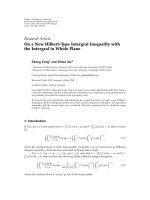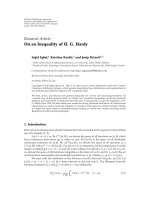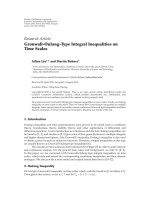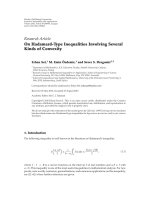Báo cáo hóa học: " Research Article On Hilbert-Pachpatte Multiple Integral Inequalities" pdf
Bạn đang xem bản rút gọn của tài liệu. Xem và tải ngay bản đầy đủ của tài liệu tại đây (470.99 KB, 7 trang )
Hindawi Publishing Corporation
Journal of Inequalities and Applications
Volume 2010, Article ID 820857, 7 pages
doi:10.1155/2010/820857
Research Article
On Hilbert-Pachpatte Multiple
Integral Inequalities
Changjian Zhao,
1
Lian-ying Chen,
1
and Wing-Sum Cheung
2
1
Department of Mathematics, College of Science, China Jiliang University,
Hangzhou 310018, China
2
Department of Mathematics, The University of Hong Kong, Pokfulam Road,
Hong Kong, China
Correspondence should be addressed to Changjian Zhao,
Received 11 March 2010; Revised 16 July 2010; Accepted 28 July 2010
Academic Editor: N. Govil
Copyright q 2010 Changjian Zhao et al. This is an open access article distributed under the
Creative Commons Attribution License, which permits unrestricted use, distribution, and
reproduction in any medium, provided the original work is properly cited.
We establish some multiple integral Hilbert-Pachpatte-type inequalities. As applications, we get
some inverse forms of Pachpatte’s inequalities which were established in 1998.
1. Introduction
In 1934, Hilbert 1 established the following well-known integral inequality.
If f ∈ L
p
0, ∞, g ∈ L
p
0, ∞, f, g ≥ 0, p>1and1/p 1/q 1, then
∞
0
∞
0
f
x
g
x
x y
dx dy ≤
π
sin
π/p
∞
0
f
p
xdx
1/p
∞
0
g
q
xdx
1/q
,
1.1
where π/sinπ/p is the best value.
In recent years, considerable attention has been given to various extensions and
improvements of the Hilbert inequality form different viewpoints 2–10. In particular,
Pachpatte 11 proved some inequalities similar to Hilbert’s integral inequalities in 1998. In
this paper, we establish some new multiple integral H ilbert-Pachpatte-type inequalities.
2 Journal of Inequalities and Applications
2. Main Results
Theorem 2.1. Let h
i
≥ 1,letf
i
σ
i
∈ C
1
x
i
, 0, 0, ∞, i 1, ,n,wherex
i
are positive real
numbers, and define F
i
s
i
0
s
i
f
i
σ
i
dσ
i
,fors
i
∈ x
i
, 0. Then for 1/α
i
1/β
i
1, 0 <β
i
< 1 and
n
i1
1/α
i
1/α,
0
x
1
···
0
x
n
n
i1
F
h
i
i
s
i
α
n
i1
1/α
i
−s
i
1/α
ds
1
···ds
n
≥
n
i1
−x
i
1/α
i
h
i
0
x
i
s
i
−x
i
F
h
i
−1
i
s
i
f
i
s
i
β
i
ds
i
1/β
i
.
2.1
Proof. From the hypotheses and in view of inverse H
¨
older integral inequality see 12,itis
easy to observe that
n
i1
F
h
i
i
s
i
n
i1
h
i
0
s
i
F
h
i
−1
i
σ
i
f
i
σ
i
dσ
i
≥
n
i1
h
i
−s
i
1/α
i
0
s
i
F
h
i
−1
i
σ
i
f
i
σ
i
β
i
dσ
i
1/β
i
,s
i
∈
x
i
, 0
,i 1, ,n.
2.2
Let us note the following means inequality:
n
i1
m
1/α
i
i
≥
α
n
i1
1
α
i
m
i
1/α
,m>0.
2.3
We obtain that
n
i1
F
h
i
i
s
i
α
n
i1
1/α
i
−s
i
1/α
≥
n
i1
h
i
0
s
i
F
h
i
−1
i
σ
i
f
i
σ
i
β
i
dσ
i
1/β
i
.
2.4
Integrating both sides of 2.4 over s
i
from x
i
i 1, 2, ,n to 0 and using the special case
of inverse H
¨
older integral inequality, we observe that
0
x
1
···
0
x
n
n
i1
F
h
i
i
s
i
α
n
i1
1/α
i
−s
i
1/α
ds
1
···ds
n
≥
n
i1
h
i
0
x
i
0
s
i
F
h
i
−1
i
σ
i
f
i
σ
i
β
i
dσ
i
1/β
i
ds
i
≥
n
i1
h
i
−x
i
1/α
i
0
x
i
0
s
i
F
h
i
−1
i
σ
i
f
i
σ
i
β
i
dσ
i
ds
i
1/β
i
n
i1
−x
i
1/α
i
h
i
0
x
i
s
i
− x
i
F
h
i
−1
i
s
i
f
i
s
i
β
i
ds
i
1/β
i
.
2.5
The proof is complete.
Journal of Inequalities and Applications 3
Remark 2.2. Taking n 2, β
i
1/2to2.1, 2.1 changes to
0
x
1
0
x
2
F
h
1
1
s
1
F
h
2
2
s
2
s
1
s
2
−2
ds
1
ds
2
≥ 4h
1
h
2
x
1
x
2
−1
0
x
1
s
1
− x
1
F
h
1
−1
1
s
1
f
1
s
1
1/2
ds
1
2
×
0
x
2
s
2
− x
2
F
h
2
−1
2
s
2
f
2
s
2
1/2
ds
2
2
.
2.6
This is just an inverse inequality similar to the following inequality which was proved by
Pachpatte 11:
x
0
y
0
F
h
s
G
l
t
s t
ds dt ≤
1
2
hl
xy
1/2
x
0
x − s
F
h−1
s
f
s
2
ds
1/2
×
y
0
y − t
G
l−1
t
g
t
2
dt
1/2
.
2.7
Theorem 2.3. Let f
i
σ
i
, F
i
s
i
, α
i
, and β
i
be as in Theorem 2.1.Letp
i
σ
i
be n positive functions
defined for σ
i
∈ x
i
, 0i 1, 2, ,n, and define P
i
s
i
0
s
i
p
i
σ
i
dσ
i
, where x
i
are positive real
numbers. Let φ
i
i 1, 2, ,n be n real-valued nonnegative, concave, and super-multiplicative
functions defined on R
.Then
0
x
1
···
0
x
n
n
i1
φ
i
F
i
s
i
α
n
i1
1/α
i
−s
i
1/α
ds
1
···ds
n
≥ L
x
1
, ,x
n
n
i1
0
x
i
s
i
− x
i
p
i
s
i
φ
i
f
i
s
i
p
i
s
i
β
i
ds
i
1/β
i
,
2.8
where
L
x
1
, ,x
n
n
i1
0
x
i
φ
i
P
i
s
i
P
i
s
i
α
i
ds
i
1/α
i
.
2.9
4 Journal of Inequalities and Applications
Proof. By using Jensen integral inequality see 11 and inverse H
¨
older integral inequality
see 12 and noticing that φ
i
i 1, 2, ,n are n real-valued super-multiplicative
functions, it is easy to observe that
φ
i
F
i
s
i
φ
i
⎛
⎝
P
i
s
i
0
s
i
p
i
σ
i
f
i
σ
i
/p
i
σ
i
dσ
i
0
s
i
p
i
σ
i
dσ
i
⎞
⎠
≥ φ
i
P
i
s
i
φ
i
⎛
⎝
0
s
i
p
i
σ
i
f
i
σ
i
/p
i
σ
i
dσ
i
0
s
i
p
i
σ
i
dσ
i
⎞
⎠
≥
φ
i
P
i
s
i
P
i
s
i
0
s
i
p
i
σ
i
φ
i
f
i
σ
i
p
i
σ
i
dσ
i
≥
φ
i
P
i
s
i
P
i
s
i
−s
i
1/α
i
0
s
i
p
i
σ
i
φ
i
f
i
σ
i
p
i
σ
i
β
i
dσ
i
1/β
i
.
2.10
In view of the means inequality and integrating two sides of 2.10 over s
i
from x
i
i
1, 2, ,n to 0 and noticing H
¨
older integral inequality, we observe that
0
x
1
···
0
x
n
n
i1
φ
i
F
i
s
i
α
n
i1
1/α
i
−s
i
1/α
ds
1
···ds
n
≥
n
i1
0
x
i
φ
i
P
i
s
i
P
i
s
i
0
s
i
p
i
σ
i
φ
i
f
i
σ
i
p
i
σ
i
β
i
dσ
i
1/β
i
ds
i
≥
n
i1
0
x
i
φ
i
P
i
s
i
P
i
s
i
α
i
ds
i
1/α
i
0
x
i
0
s
i
p
i
σ
i
φ
i
f
i
σ
i
p
i
σ
i
β
i
dσ
i
ds
i
1/β
i
L
x
1
, ,x
n
n
i1
0
x
i
s
i
− x
i
p
i
s
i
φ
i
f
i
s
i
p
i
s
i
β
i
ds
i
1/β
i
.
2.11
This completes the proof of Theorem 2.3.
Remark 2.4. Taking n 2, β
i
1/2to2.8, 2.8 changes to
0
x
1
0
x
2
φ
1
F
1
s
1
φ
2
F
2
s
2
s
1
s
2
−2
ds
1
ds
2
≥ L
x
1
,x
2
⎛
⎝
0
x
1
s
1
− x
1
p
1
s
1
φ
1
f
1
s
1
p
1
s
1
1/2
ds
1
⎞
⎠
2
×
0
x
2
s
2
− x
2
p
2
s
2
φ
2
f
2
s
2
p
2
s
2
1/2
ds
2
2
,
2.12
Journal of Inequalities and Applications 5
where
L
x
1
,x
2
4
0
x
1
φ
1
P
1
s
1
P
1
s
1
−1
ds
1
−1
0
x
2
φ
2
P
2
s
2
P
2
s
2
−1
ds
2
−1
.
2.13
This is just an inverse inequality similar to the following inequality which was proved by
Pachpatte 11:
x
0
y
0
φ
F
s
ψ
G
t
s t
ds dt ≤ L
x, y
x
0
x − s
p
s
φ
f
s
p
s
2
ds
1/2
×
y
0
y − t
q
t
ψ
g
t
q
t
2
dt
1/2
,
2.14
where
L
x, y
1
2
x
0
φ
P
s
P
s
2
ds
1/2
y
0
ψ
Q
t
Q
t
2
dt
1/2
.
2.15
Theorem 2.5. Let f
i
σ
i
, p
i
σ
i
, P
i
σ
i
, α
i
, and β
i
be as Theorem 2.3, and define F
i
s
i
1/P
i
s
i
0
s
i
p
i
σ
i
f
i
σ
i
dσ
i
for σ
i
,s
i
∈ x
i
, 0,wherex
i
are positive real numbers. Let φ
i
i
1, 2, ,n be n real-valued, nonnegative, and concave functions on R
.Then
0
x
1
···
0
x
n
n
i1
P
i
s
i
φ
i
F
i
s
i
α
n
i1
1/α
i
−s
i
1/α
ds
1
···ds
n
≥
n
i1
x
1/α
i
i
0
x
i
s
i
− x
i
p
i
s
i
φ
i
f
i
s
i
β
i
ds
i
1/β
i
.
2.16
Proof. From the hypotheses and by using Jensen integral inequality and the inverse H
¨
older
integral inequality, we have
φ
i
F
i
s
i
φ
i
1
P
i
s
i
0
s
i
p
i
σ
i
f
i
σ
i
dσ
i
≥
1
P
i
s
i
0
s
i
p
i
σ
i
φ
i
f
i
σ
i
dσ
i
≥
1
P
i
s
i
−s
i
1/α
i
0
s
i
p
i
σ
i
φ
i
f
i
σ
i
β
i
dσ
i
1/β
i
.
2.17
6 Journal of Inequalities and Applications
Hence
0
x
1
···
0
x
n
n
i1
P
i
s
i
φ
i
F
i
s
i
α
n
i1
1/α
i
−s
i
1/α
ds
1
···ds
n
≥
n
i1
0
x
i
0
s
i
p
i
σ
i
φ
i
f
i
σ
i
β
i
dσ
i
1/β
i
ds
i
≥
n
i1
x
1/α
i
i
0
x
i
0
s
i
p
i
σ
i
φ
i
f
i
σ
i
β
i
dσ
i
ds
i
1/β
i
n
i1
−x
i
1/α
i
0
x
i
s
i
− x
i
p
i
s
i
φ
i
f
i
s
i
β
i
ds
i
1/β
i
.
2.18
Remark 2.6. Taking n 2, β
i
1/2to2.16, 2.16 changes to
0
x
1
0
x
2
P
1
s
1
P
2
s
2
φ
1
F
1
s
1
φ
2
F
2
s
2
s
1
s
2
−2
ds
1
ds
2
≥ 4
x
1
x
2
−1
0
x
1
s
1
− x
1
p
1
s
1
φ
1
f
1
s
1
1/2
ds
1
2
×
0
x
2
s
2
− x
2
p
2
s
2
φ
2
f
2
s
2
1/2
ds
2
2
.
2.19
This is just an inverse inequality similar to the following inequality which was proved by
Pachpatte 11:
x
0
y
0
P
s
Q
t
φ
F
s
ψ
G
t
s t
ds dt
≤
1
2
xy
1/2
x
0
x − s
p
s
φ
f
s
2
ds
1/2
y
0
y − t
q
t
ψ
g
t
2
dt
1/2
.
2.20
Remark 2.7. In 2.20,ifp
1
s
1
p
2
s
2
1, then P
1
s
1
s
1
, P
2
s
2
s
2
. Therefore 2.20
changes to
0
x
1
0
x
2
φ
1
F
1
s
1
φ
2
F
2
s
2
s
1
s
2
−2
ds
1
ds
2
≥ 4
x
1
x
2
−1
0
x
1
s
1
− x
1
φ
1
f
1
s
1
1/2
ds
1
2
0
x
2
s
2
− x
2
φ
2
f
2
s
2
1/2
ds
2
2
.
2.21
Journal of Inequalities and Applications 7
This is just an inverse inequality similar to the following Inequality which was proved by
Pachpatte 11:
x
0
y
0
φ
F
s
ψ
G
t
st
−1
s t
ds dt
≤
1
2
xy
1/2
x
0
x − s
φ
f
s
2
ds
1/2
y
0
y − t
ψ
g
t
2
dt
1/2
.
2.22
Acknowledgments
This paper is supported by the National Natural Sciences Foundation of China 10971205.
This paper is partially supported by the Research Grants Council of the Hong Kong SAR,
China Project no. HKU7016/07P and an HKU Seed Grant for Basic Research.
References
1 G. H. Hardy, J. E. Littlewood, and G. P
´
olya, Inequalities, Cambridge University Press, Cambridge,
Mass, USA, 1952.
2 B. Yang, “On a relation between Hilbert’s inequality and a Hilbert-type inequality,” Applied
Mathematics Letters, vol. 21, no. 5, pp. 483–488, 2008.
3 G. A. Anastassiou, “Hilbert-Pachpatte type general multivariate integral inequalities,” International
Journal of Applied Mathematics, vol. 20, no. 4, pp. 549–573, 2007.
4 B. C. Yang, “Hilbert’s inequality with some parameters,” Acta Mathematica Sinica,vol.49,no.5,pp.
1121–1126, 2006.
5 J. C. Kuang and L. Debnath, “The general form of Hilbert’s inequality and its converses,” Analysis
Mathematica, vol. 31, no. 3, pp. 163–173, 2005.
6 C J. Zhao and W S. Cheung, “Sharp integral inequalities involving high-order partial derivatives,”
Journal of Inequalities and Applications, vol. 2008, Article ID 571417, 10 pages, 2008.
7 Z. Changjian, J. Pecari
´
c, and L. Gangsong, “Inverses of some new inequalities similar to Hilbert’s
inequalities,” Taiwanese Journal of Mathematics, vol. 10, no. 3, pp. 699–712, 2006.
8 B. Yang, “On new generalizations of Hilbert’s inequality,” Journal of Mathematical Analysis and
Applications, vol. 248, no. 1, pp. 29–40, 2000.
9 J. C. Kuang, “On new extensions of Hilbert’s integral inequality,” Journal of Mathematical Analysis and
Applications, vol. 235, no. 2, pp. 608–614, 1999.
10 M. Gao and B. Yang, “On the extended Hilbert’s inequality,” Proceedings of the American Mathematical
Society, vol. 126, no. 3, pp. 751–759, 1998.
11 B. G. Pachpatte, “On some new inequalities similar to Hilbert’s inequality,” Journal of Mathematical
Analysis and Applications, vol. 226, no. 1, pp. 166–179, 1998.
12 E. F. Beckenbach and R. Bellman, Inequalities, Ergebnisse der Mathematik und ihrer Grenzgebiete, N.
F., Bd. 30, Springer, Berlin, Germany, 1961.









